 W
WThe Early Middle Ages in Romania started with the withdrawal of the Roman troops and administration from Dacia province in the 270s. In the next millennium a series of peoples, most of whom only controlled two or three of the nearly ten historical regions that now form Romania, arrived. During this period, society and culture underwent fundamental changes. Town life came to an end in Dacia with the Roman withdrawal, and in Scythia Minor – the other Roman province in the territory of present-day Romania – 400 years later. Fine vessels made on fast potter's wheels disappeared and hand-made pottery became dominant from the 450s. Burial rites changed more than once from cremation to inhumation and vice versa until inhumation became dominant by the end of the 10th century.
 W
WThe Pannonian Avars were an alliance of several groups of Eurasian nomads of unknown origins.
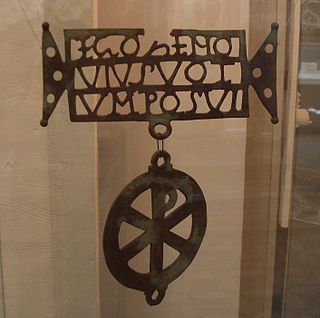 W
WThe Biertan Donarium is a fourth-century Christian votive object found near the town of Biertan, in Transylvania, Romania.
 W
WThe Bulgars were Turkic semi-nomadic warrior tribes that flourished in the Pontic–Caspian steppe and the Volga region during the 7th century. They became known as nomadic equestrians in the Volga-Ural region, but some researchers say that their ethnic roots can be traced to Central Asia. During their westward migration across the Eurasian steppe, the Bulgar tribes absorbed other ethnic groups and cultural influences in a process of ethnogenesis, including Indo-European, Finno-Ugric and Hunnic tribes. Modern genetic research on Central Asian Turkic people and ethnic groups related to the Bulgars points to an affiliation with Western Eurasian populations. The Bulgars spoke a Turkic language, i.e. Bulgar language of Oghuric branch. They preserved the military titles, organization and customs of Eurasian steppes, as well as pagan shamanism and belief in the sky deity Tangra.
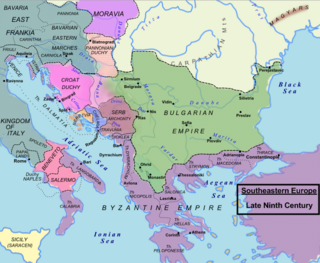 W
WThe First Bulgarian Empire was a medieval Bulgar-Slavic and later Bulgarian state that existed in Southeastern Europe between the 7th and 11th centuries AD. It was founded in 681 when Bulgar tribes led by Asparuh moved to the northeastern Balkans. There they secured Byzantine recognition of their right to settle south of the Danube by defeating – possibly with the help of local South Slavic tribes – the Byzantine army led by Constantine IV. At the height of its power, Bulgaria spread from the Danube Bend to the Black Sea and from the Dnieper River to the Adriatic Sea.
 W
WIn the Middle Ages the Bulgarian Empire controlled vast areas to the north of the river Danube from its establishment in 681 to its fragmentation in 1371-1422. These lands were called by contemporary Byzantine historians Bulgaria across the Danube, or Transdanubian Bulgaria. Original information for the centuries-old Bulgarian rule there is scarce as the archives of the Bulgarian rulers were destroyed and little is mentioned for this area in Byzantine or Hungarian manuscripts.
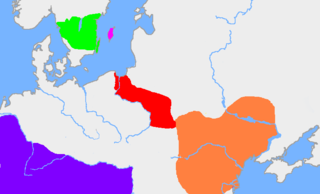 W
WThe Chernyakhov culture, or Sântana de Mureș culture, is an archaeological culture that flourished between the 2nd and 5th centuries AD in a wide area of Eastern Europe, specifically in what is now Ukraine, Romania, Moldova and parts of Belarus. The culture is thought to be the result of a multiethnic cultural mix of the Sarmatian, Slavic, Gothic, and Geto-Dacian populations of the area.
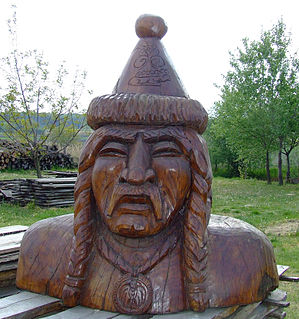 W
WCsanád, also Chanadinus, or Cenad, was the first head (comes) of Csanád County in the Kingdom of Hungary in the first decades of the 11th century.
 W
WThe Cumans, also known as Polovtsians or Polovtsy, were a Turkic nomadic people comprising the western branch of the Cuman–Kipchak confederation. After the Mongol invasion (1237), many sought asylum in the Kingdom of Hungary, as many Cumans had settled in Hungary, the Second Bulgarian Empire playing an important role in the development of the state, and Anatolia before the invasion.
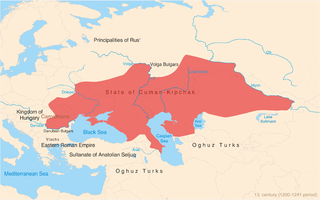 W
WThe name Cumania originated as the Latin exonym for the Cuman–Kipchak confederation, which was a Turkic confederation in the western part of the Eurasian Steppe, between the 10th and 13th centuries. The confederation was dominated by two Turkic nomadic tribes: the Cumans and the Kipchaks. Cumania was known in Islamic sources as Desht-i Qipchaq, which means "Steppe of the Kipchaks"; or "foreign land sheltering the Kipchaks", in the Turkic languages. Russian sources have referred to Cumania as the "Polovtsian Steppe", or the "Polovcian Plain".
 W
WGelou was the Vlach ruler of Transylvania at the time of the Hungarian conquest of the Carpathian Basin around 900 AD, according to the Gesta Hungarorum. Although the Gesta Hungarorum, which was written after 1150, does not indicate the enemies of the conquering Hungarians (Magyars) known from earlier annals and chronicles, it refers to local rulers—including Gelou—who are not mentioned in other primary sources. Consequently, historians debate whether Gelou was a historical person or an imaginary figure created by the unidentified author of the Gesta Hungarorum. In Romanian historiography, Gelou is one of three early-10th-century Romanian dukes with lands in the intra-Carpathian region of present-day Romania.
 W
WThe Gepids were an East Germanic tribe who lived in the area of modern Romania, Hungary and Serbia, roughly between the Tisza, Sava and Carpathian mountains. They were closely related to, or a subdivision of, the Goths.
 W
WOld Great Bulgaria or Great Bulgaria, also often known by the Latin names Magna Bulgaria and Patria Onoguria, was a 7th-century state formed by the Onogur Bulgars on the western Pontic–Caspian steppe. Great Bulgaria was originally centered between the Dniester and lower Volga.
 W
WThe Pechenegs or Patzinaks were a semi-nomadic Turkic people from Central Asia speaking the Pecheneg language which belonged to the Oghuz branch of the Turkic language family.
 W
WThe Taifals or Tayfals were a people group of Germanic or Sarmatian origin, first documented north of the lower Danube in the mid third century AD. They experienced an unsettled and fragmented history, for the most part in association with various Gothic peoples, and alternately fighting against or for the Romans. In the late fourth century some Taifali were settled within the Roman Empire, notably in western Gaul in the modern province of Poitou. They subsequently supplied mounted units to the Roman army and continued to be a significant source of cavalry for early Merovingian armies. By the sixth century their region of western Gaul had acquired a distinct identity as Thifalia.
 W
WVicina was a town on the Danube used as a tradepost (Emporia) by the Republic of Genoa, being part of the Genoese trade empire between the 13th and 14th century. At one time, it was the most flourishing port of the maritime Danube, but its importance declined with the development of other ports such as Kilia and Brăila. Although many locations have been proposed by both historians and archeologists as the remains of Vicina, it is still unknown where this town was located.